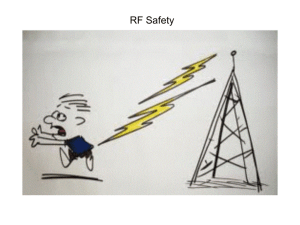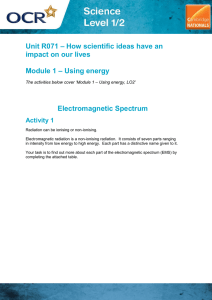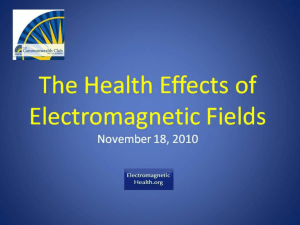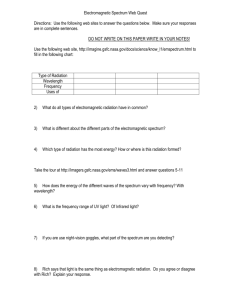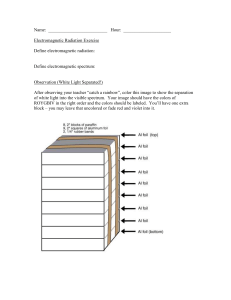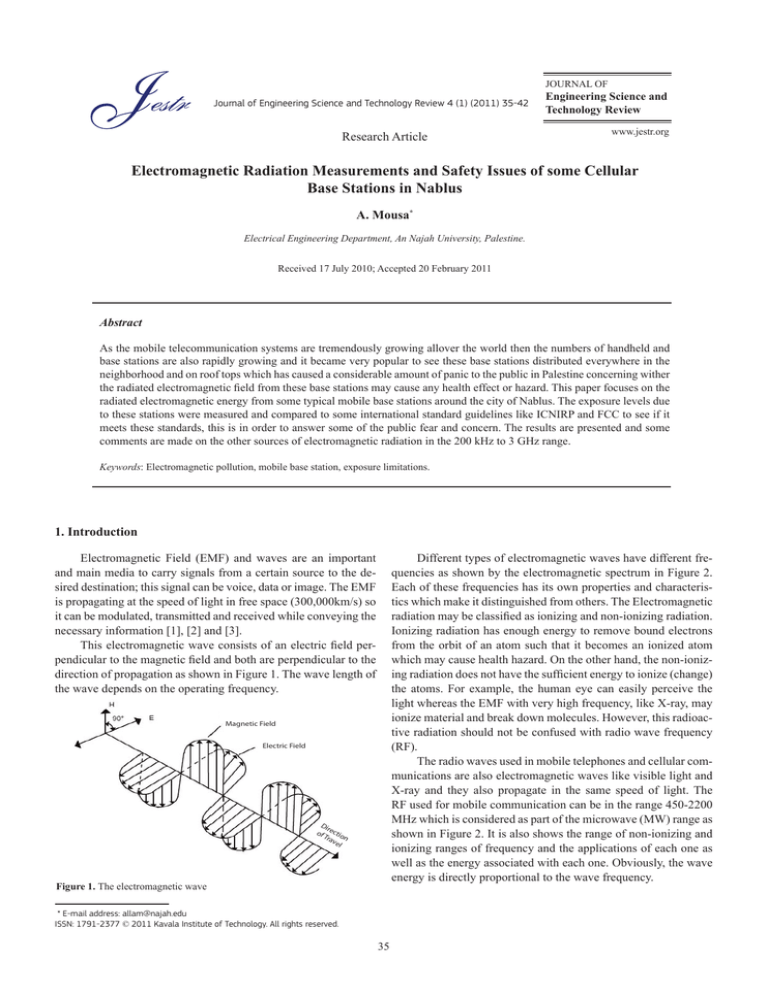
JOURNAL OF
Journal of Engineering Science and Technology Review 4 (1) (2011) 35-42
Research Article
Engineering Science and
Technology Review
www.jestr.org
Electromagnetic Radiation Measurements and Safety Issues of some Cellular
Base Stations in Nablus
A. Mousa*
Electrical Engineering Department, An Najah University, Palestine.
Received 17 July 2010; Accepted 20 February 2011
Abstract
As the mobile telecommunication systems are tremendously growing allover the world then the numbers of handheld and
base stations are also rapidly growing and it became very popular to see these base stations distributed everywhere in the
neighborhood and on roof tops which has caused a considerable amount of panic to the public in Palestine concerning wither
the radiated electromagnetic field from these base stations may cause any health effect or hazard. This paper focuses on the
radiated electromagnetic energy from some typical mobile base stations around the city of Nablus. The exposure levels due
to these stations were measured and compared to some international standard guidelines like ICNIRP and FCC to see if it
meets these standards, this is in order to answer some of the public fear and concern. The results are presented and some
comments are made on the other sources of electromagnetic radiation in the 200 kHz to 3 GHz range.
Keywords: Electromagnetic pollution, mobile base station, exposure limitations.
1. Introduction
Different types of electromagnetic waves have different frequencies as shown by the electromagnetic spectrum in Figure 2.
Each of these frequencies has its own properties and characteristics which make it distinguished from others. The Electromagnetic
radiation may be classified as ionizing and non-ionizing radiation.
Ionizing radiation has enough energy to remove bound electrons
from the orbit of an atom such that it becomes an ionized atom
which may cause health hazard. On the other hand, the non-ionizing radiation does not have the sufficient energy to ionize (change)
the atoms. For example, the human eye can easily perceive the
light whereas the EMF with very high frequency, like X-ray, may
ionize material and break down molecules. However, this radioactive radiation should not be confused with radio wave frequency
(RF).
The radio waves used in mobile telephones and cellular communications are also electromagnetic waves like visible light and
X-ray and they also propagate in the same speed of light. The
RF used for mobile communication can be in the range 450-2200
MHz which is considered as part of the microwave (MW) range as
shown in Figure 2. It is also shows the range of non-ionizing and
ionizing ranges of frequency and the applications of each one as
well as the energy associated with each one. Obviously, the wave
energy is directly proportional to the wave frequency.
Electromagnetic Field (EMF) and waves are an important
and main media to carry signals from a certain source to the desired destination; this signal can be voice, data or image. The EMF
is propagating at the speed of light in free space (300,000km/s) so
it can be modulated, transmitted and received while conveying the
necessary information [1], [2] and [3].
This electromagnetic wave consists of an electric field perpendicular to the magnetic field and both are perpendicular to the
direction of propagation as shown in Figure 1. The wave length of
the wave depends on the operating frequency.
Magnetic Field
Electric Field
Dir
of ectio
Tra n
ve
l
Figure 1. The electromagnetic wave
* E-mail address: allam@najah.edu
ISSN: 1791-2377 © 2011 Kavala Institute of Technology. All rights reserved.
35
A. Mousa / Journal of Engineering Science and Technology Review 4 (1) (2011) 35-42
Table 3. Mobile radio systems in Japan.
IONIZING
NON - IONIZING
� Radiofrequencies�
Visible
Light
Power Lines
Radio and
Television
Microwaves
Ultra
violet
Infra-red
X-rays
Gamma Rays
Cellular system
Trans- Multiple Channel
GenerYear mission access
Bandation
type
type
width
J-TACS
1985
Analog
FDMA
900MHz
1st
PDC
1986
Digital
TDMA
900MHz
2nd
CDMA one (KDDI)
2000
Digital
CDMA
900MHz
2nd
UMTS WCDMA (NTT Docomo) 2001
Digital
CDMA
2000MHz
3rd
Frequency
(Hertz)
Energy (eV)
�
Cellular Radio
10 102 103 104 105 106 107 108 109 1010 1011 1012 1013 1014 1015 1016 1017 1018 1019 1020 1021 1022 1023 1024 1025 1026
10-13 10-12 10-11 10-10 10-9 10-8 10-7 10-6 10-5 10-4 10-3 10-2 0,1
1
10 102 103 104 105 106 107 108 109 1010 1011
Figure 2. The electromagnetic spectrum, energy and some applications
Considering the GSM system as one of the most popular cellular system allover the world and being the one which is adopted
and operating in Palestine, then the operating frequency may be
summarized as shown in Table 4.
2. Cellular Networks
A cellular communication system is one of the most increasing
telecommunication sectors. It consists of several transmitters,
called base stations, covering adjoining zones, called cells, and
the used mobile phones. There exist several mobile radio systems
in the world ranging from analog to digital systems and having
different multiple access types and frequency carriers. The main
three systems are the North America, European and Japan systems
where each of these systems was developed and through generations. The specifications of these systems are illustrated in Table
1, Table 2 and Table 3 respectively.
Table 4. GSM frequency Spectrum.
Year
Transmission type
Advanced Mobile
Phone system
AMPS
Multiple
access
type
1983
Analog
FDMA
800MHz
1st
Narrowband
AMPS
1992
Analog
FDMA
800MHz
1st
US Digital Cellular
Digital AMPS
1991
IS-45/IS-136
Digital
TDMA
800/
1900MHz
2nd
US Narrowband
Spread Spectrum
IS-95,CDMAone
1993
Digital
CDMA
800/
1900MHz
2nd
CDMA-2000
2001
Digital
CDMA
1900MHz
3rd
Table 2. Mobile radio systems around the world.
Multiple
Year Trans-misaccess
sion type
type
Total Access
Communication
ETACS
1985
Analog
FDMA
900MHz
1st
Nordic Mobile
Telephone
NMT-900
1986
Analog
FDMA
450/900MHz
1st
Global system of
Mobile GSM
1990
Digital
TDMA
900/1800
MHz
2nd
UNIVERSAL
Mobile Telecom
System
UMTS WCDMA
2001
Digital
CDMA
2000MHz
2nd
Downlink (MHz)
900
890-915
935-960
1800
1710-1785
1805-1880
1900
1850-1910
1930-1990
The cells radii many vary in size according to the desired capacity and geographical area to be covered, this ranges from tens of
meters in buildings, and hundreds of meters in cities up to tens of
kilometers in the countryside [4]. Each of these cells is covered by
the allocated base station which is responsible for transmitting and
receiving the radio signal required to establish the communication
between users. The base station must be designed in a way such
that each cell in the network can perform efficiently to achieve
good signal, minimum congestion or call drop and no interference
[5]. The RF power should be assigned to achieve these goals. It
should be large enough to provide coverage and quality but small
enough to prevent interference.
To complete a call from any mobile phone, the network assigns a certain available RF channel within the cell that covers
the named mobile phone, if this cell is congested then this mobile
phone is connected through a neighboring cell, the call is then
routed to a switch that will proceed conventionally to the final
destination being mobile or fixed destination. In case the user is
moving and will cross the boundary of a cell into the range of a
neighboring one, the network will “handover” the call from the
serving base station into an other one that can provide coverage
Channel GeneraBandwidth
tion
Cellular system
Uplink (MHz)
I) Base Station
Table 1. Mobile radio systems in USA.
Cellular system
GSM range (MHz)
Channel GeneraBandwidth
tion
Figure 3. Neighboring cells
36
A. Mousa / Journal of Engineering Science and Technology Review 4 (1) (2011) 35-42
Table 5. Advantages and disadvantages of small cells cellular
communication system.
and capacity to this on-going call. An illustration of the neighboring cells is shown in Figure 3. The shape of cells are not perfect
circles or hexagonal, but it depends on the environment such as
buildings and mountains, it also depends on weather conditions
and even system load [4], [5].
It is important to mention here that multiple cells are needed
to cover an area both in capacity and signal strength, this is due to
the fact that each cell can provide a limited number of instantaneous calls [5]. Hence, as the number of base stations operating at
particular carrier frequency increases in a certain area the cell size
gets smaller and so less power is required, for transmission, to
cover this small-sized cell.
To achieve the desired goals of the base station, antennas
with certain power, orientation and gain should be chosen and
fixed properly. The gain of the antenna is important but also it
should be mounted clearly with no obstacles that may reduce the
coverage or signal strength of the base station since these obstacles will force the base station to use higher power to cover the
cell which is waste of resources and may cause interference with
the neighboring cells. The coverage area of a typical antenna is
illustrated in Figure 4 [6].
Base station
mast
Advantages
High capacity
Less transmission power
Local interference
Infrastructure needed
Hardware needed
Frequency planning
Robustness to failure at single
component
II) Mobile phones
Mobile phones are connected to the base stations via radiofrequency electromagnetic waves (RF-EMF). These mobile phones should
be in the coverage area of a certain cell; the base station of this cell
must assign this mobile phone the necessary RF channel to maintain the connection. To achieve this link, the mobile should use
certain transmission power to connect to the base station (uplink)
and the base station should use the required power to connect to the
mobile phone (down link).
Similar to the base station case, the mobile phone should not
have obstacles since this reduces the signal strength and so the
quality becomes poor. Increasing the transmission power means
the mobile will not work on the minimum power which results in
waste of resources and lose of battery life as well as other problems
that may arise.
It is important to conserve the battery life and to minimize
the interference between cells and hence the mobile transmission
power is limited to the minimum level required to maintain the
connection and so it is better to be close to the base station so as to
reduces the transmission power in both directions.
Antenna
5 - 100
Disadvantages
Beam
15 - 50 m
50 - 300 m
Figure 4. Direction of coverage due to a base station antenna
In small cells case, where mobile phones are highly used,
antennas may be installed on building roofs and sides or on small
poles (low impact facilities), while in the case of large cells (low
usage area), the antennas are usually mounted on masts and towers to deal with the large distances and gains. In both cases, it is
desired to maintain service quality to all users. Typical antenna
types and way of fixing is illustrated in Figure 5.
III) Quality in Mobile Communications
The sound quality in mobile communications depends on two
items [4], [5], [6]) Strength of the radio signal to convey the data,
and 2) No other strong RF signals should present at the same or
even adjacent frequencies. To achieve these two points, the mobile
and base station must use the appropriate output power. The intensity of the EMF is decreased as the distance from the antenna is
increased, this enables use of the same frequency in a new cell at a
certain distance from the first base station without any disturbance
between these two cells, this is called “frequency-reuse” which is
so important to be optimized since the mobile network is limited in
frequency spectrum [6].
Actually, the power density (intensity) decreases by a factor of
the square of the distance as one move away from the base station.
Moreover, the intensity is proportional to the transmitter’s output
power. Typically the available mobiles have a maximum output
power of one watt, but only a fraction of this power is used to
establish good communication under the normal conditions. Some
typical values of the handset output power, for the most common
mobile phone systems, is given in Table 6.
The output power of a base station ranges from few watts for
Figure 5. Several antenna types mounted
Typical heights of these antennas are 15-50 meter from
ground. A base station may consist of several “omni directional”
antennas, each one is directed to a certain geographical direction,
and the signal from this antenna is directed to cover the desired
area in a relatively narrow beam in the vertical plane as shown in
Figure 4. The advantages and disadvantages of cellular systems
with small cells are shown in Table 5.
37
A. Mousa / Journal of Engineering Science and Technology Review 4 (1) (2011) 35-42
both the general public (unconditional exposure) and those who
are working with this field (occupational exposure). These exposure guidelines are usually similar and are based on the thresholds
for known adverse effects and they have a margin of safety in
order to protect people from the health effects of both short and
long term exposure to EMF [13]. Some of these standards were
organized and developed by the following organizations;
small cells to hundreds of watts for huge cells depending on some
parameters such as the type and location. Moreover, this power is
usually directed so that the signal is stronger in some directions and
weak in the others as it is desired.
Table 6. Typical output power of certain mobile phones handsets.
Mobile
telephone
system
Where primarily used
Type
Frequency
band (MHz)
NMT
Scandinavia
Analog
900
ETACS
UK, Asia
Analog
900
0.6
AMPS
America, Asia,
Australia
Analog
800
0.6
D-AMPS
America, Asia
Digital
800/1900
0.2
GSM
Europe, Asia,
Australia
Digital
900
0.25
PDC
Japan
Digital
800/1500
0.2
GSM1800
Europe, Asia
Digital
1800
0.125
GSM1900
North America
Digital
1900
0.125
DECT
Europe, Asia
Digital
1900
0.01
Handset output
power (W)
(maximum)
1) World Health Organization (WHO) [13]
2)International Commission on Non-Ionizing Radiation Protection [14]
3) Federal Communications Commission (FCC).
4) Institute of Electrical and Electronic Engineering (IEEE).
5) Environmental Protection Agency (EPA).
6) Food and Drug Administration (FDA).
7) American Cancer Society (ACS)
8)National Institute for Occupational Safety and Health (NIOSH).
9) Occupational safety and Health Administration (OSHA)
10)National Council of Radiation Protection and Measurements (NCRPM).
11)Australian Radiation Protection and Nuclear Safety Agency (ARPNSA).
The importance of WHO is that it has established the “International EMF Project” to review the scientific literature concerning the biological effects of electromagnetic fields. The main aim
of this project is to provide a frame work for the international
harmonization of RF safety standards [13]. The ICNIRP is considered as the most important organization specifying radio frequency EMF limits due to the following items [14];
3. Safety Guidelines to Level of Exposure
Since it was first introduced around 1980, almost all classes of society are using mobile phones. The estimated number of mobile
phone users is around 1.5 billion all over the world [7]. The Cellular Telecommunication Industry Association (CTIA) has reported
that this industry is growing at a rate of 40% per year [8]. This so
fast rapid deployment of mobile telecommunications networks in
the world has alert public concern over possible health effects from
exposure to radiofrequency electromagnetic energy (RF EME)
emitted by both mobile phones and base station antennas.
a) ICNIRP guidelines were published in 1998.
b)Limits are based on all available scientific research and
include large safety margins.
c)Limits are set to protect all people from established adverse health effect from short and long term exposure.
d)Specifies limits for both general public and occupational
exposure.
e) Endorsed by WHO.
I) Health and Safety
The exposure to very high levels of RF energy can be harmful and
may cause some biological effects on human [9], [10], these effects
may result from heating of tissues and it is called “thermal effects”
this is mainly due to the ability of RF energy to heat biological
tissue, this is the same as the principle of the microwave oven. On
the other hand, at low levels of exposure to RF radiation (lower
than the threshold which may cause heat), the evidence of harmful biological effects is unproven; however it may cause some non
thermal effects [11]. At the extremely high frequencies like X-rays,
electromagnetic particles have sufficient energy to break bonds
(ionization). This is why genetic material of cells may be damaged
leading to cancer or birth defects. However, at lower frequencies,
such as the RF ones used by cellular communications, the energy
of the particles is too much low to break chemical bonds. Thus, RF
energy is non-ionizing [12]
When the distance to the radio transmitter is in the far field
(greater then few wavelengths, i.e., around one meter for RF),
safety limits are usually expressed as field strength. The field intensity is usually applied to exposure from base stations. Since RF
waves have both electric and magnetic components, the electric
field strength is measured in volts per meter (v/m) and the magnetic field is measured in amperes per meter (A/m). A commonly
used unit to characterize the RF electromagnetic field is the plane
wave power density especially at the far field. This density is defined as the power per unit area; it may be expressed in terms of
watts per square meter (w/m²), milliwatts per square centimeter
(mw/cm²) or microwatts per square centimeter (µw/cm²).
For the case where the exposure is local (RF is transmitted
from the mobile phone and hence closer to the user), the highest
power absorption per unit mass in a small part of the body must
be used and compared with the recommendations and standards.
Specific Absorption Rate (SAR) is the quantity used to measure
this amount of RF energy and it is expressed in units of watts per
kilogram (W/kg) or (mW/kg).
II) Standards and Limitations
The main concern of RF exposure has started some sixty years ago
where several national and international standards, regulations
and recommendations for RF energy exposure were developed for
38
A. Mousa / Journal of Engineering Science and Technology Review 4 (1) (2011) 35-42
Table 8. ICNIRP reference levels for Maximum Permissible Exposure (MPE).
The Maximum Permissible Exposure (MPE) recommended
for power density is based on the threshold SAR value. However
some guidelines may vary from each other for different operating
frequencies. Actually, Whole-body human absorption of RF energy varies with the frequency of the RF wave [11]. The frequency
range of 30-300 MHZ is considered as the resonance range to human body where it absorbs the energy efficiently when the whole
body is exposed [11].
The Maximum Permissible Exposure (MPE) limits adopted
by FCC in 1996 for both occupational and general public exposure
expressed in terms of electric field strength (E, v/m) and magnetic
field strength (H, a/m) and power density (S, w/m2) for a wide
frequency range are given in Table 7. Similarly, the ICNIRP limits
for frequencies up to 300 GHz are given in Table 8. The details
of the MPE for both ICNIRP and FCC are given in [14] and [15]
respectively. In the far field of a transmitting antenna (plane wave
case) the magnetic field may be given as E/377 and the power
density is calculated as given in Eq.1.
E2
S=
377
A) Limits for Occupational/Controlled Exposure*
Frequency
Range
E-field
strength
(Vm-1)
H-field
strength
(Am-1)
Up to 1Hz
-
1.63*105
1-8 Hz
20,000
1.63*10 /f
2*10 /f
-
8-25 Hz
20,000
2*104/f
2.5*104/f
-
500/f
20/f
25/f
-
0.025-0.82 kHz
2
610
24.4
30.7
-
0.065-1 MHz
610
1.6/f
2.0/f
-
610/f
1.6/f
2.0/f
-
10-400 MHz
61
0.16
0.2
10
400-2000 MHz
3f1/2
0.008f1/2
0.01f1/2
f/40
2-300 GHz
137
0.36
0.45
50
Frequency
Range
E-field
strength
(Vm-1)
H-field
strength
(Am-1)
B-field
(µT)
Up to 1Hz
-
3.2×104
4×104
-
1-8 Hz
10.000
3.2×104/f
4×104/f
-
8-25 Hz
(A) Limits for Occupational/Controlled Exposure
Power
density
(S)
(mW/cm2)
-
5
(B) Limits for General Populations/Uncontrolled Exposure*
Table 7. FCC Limits for Maximum Permissible Exposure (MPE).
Electric field Magnetic field
Strength (E) Strength (H)
(V/m)
(A/m)
2*105
*Note:1 f as indicated in the frequency range column.
Where E is the electric field strength (v/m)
Frequency
Range
(MHz)
2
Equivalent plane
wave power density Seq (Wm-2)
0.82-65 KHz
1-10 MHz
(1)
5
B-field
(µT)
Averaging
Time
|E|2,|H|2 or S
(minutes)
Equivalent plane
wave power density Seq (Wm-2)
10.000
4.000/f
5,000/f
-
0.025-0.8 kHz
250/f
4/f
5/f
-
0.3-3.0
614
1.63
(100)*
6
0.8-3 kHz
250/f
5
6.25
-
3.0-30
1842/f
4.89/f
(900/f2)*
6
3-150 kHz
87
5
6.25
-
30-300
61.4
0.163
1.0
6
0.15-1 MHz
87
0.73/f
0.92/f
-
87/ f
0.73/f
0.92/f
-
28
0.073
0.092
2
1.375 f1/2
0.0037 f1/2
0.0046 f1/2
f/200
61
0.16
0.20
10
300-1500
--
--
f/300
6
1500-100,000
--
--
5
6
1-10 MHz
10-400 MHz
400-2000 MHz
2-300 GHz
*Note: 1 f as indicated in the frequency range column.
(B) Limits for General Population/Uncontrolled Exposure
Frequency
Range
(MHz)
Electric field Magnetic field
Strength (E) Strength (H)
(V/m)
(A/m)
Power
density
(S)
(mW/cm2)
Averaging
Time
|E|2,|H|2 or S
(minutes)
0.3-1.34
614
1.63
(100)*
30
1.34-30
824/f
2.19/f
(180/f2)*
30
30-300
27.5
0.073
0.2
30
300-1500
--
--
f/1500
30
1500-100,000
--
--
1.0
30
f = frequency in MHz equivalent power density
1/2
It is clear from these recommendations that the MPE is a
function of the operating frequency. Hence for 900 MHz the MPE
for both FCC and CNIRP is shown in the Table 9.
Table 9. MPE for both FCC and ICNIRP at 900MHZ.
FCC (W/ m²)
ICNIRP (W/ m²)
General public exposure
6
4.5
Occupational exposure
30
22.5
The Specific Absorption Rate (SAR) is a value that corresponds to the relative amount of RF energy absorbed by certain
amount of the tissues of the body which is exposed to RF radiation.
The FCC adopted limits for localized ‘partial body’ absorption in
*Plane-wave
39
A. Mousa / Journal of Engineering Science and Technology Review 4 (1) (2011) 35-42
Up to 1Hz
40
-
-
-
1-4Hz
40/f
-
-
-
4Hz-1kHz
10
-
-
-
1-100kHz
f/100
-
-
-
100kHz10MHz
f/100
0.4
10
20
quirements concerns the worst case estimate of the RF-EMF public
exposure before the development can occur. Initially, some prediction values can be considered for the RF-EMF using some software
tools, this can be achieved theoretically before the site is constructed. However, more accurate results can be obtained by measuring
the radiated levels and compare it to the calculated ones. Measuring the exposure levels at a certain number of sites is necessary to
verify the calculations and assess the actual exposure levels.
As this work focuses on the already constructed and operating base stations, then the radiation measurement is the practical
issue to be performed. This has to be repeated occasionally and the
values are to be compared with the international guidelines. Hence,
sensitive equipment is required to measure the radio signals around
the area of interest. A power density meter may be used to measure
the electric field, magnetic field and power density in the vicinity
of a mobile base station.
The device which was used here has an isotropic antenna and
works in the frequency range of 0.2-3GHz. This relatively wide
range covers many common radio frequencies but not only the cellular communication band and so the measured power density values are not due to the mobile base station only. A portable electric
field meter (E field) with detachable isotropic probe was used to
take the necessary readings. The main specifications of the measuring device are illustrated in Table 12.
10MHz10GHz
-
0.4
10
20
Table 12. Specifications of the field measuring device.
Up to 1Hz
8
-
-
-
Wide dynamic range:
1-4Hz
8/f
-
-
-
4 Hz-1kHz
2
-
-
-
Resolution (at range):
terms of SAR, which apply to certain portable transmitters such as
hand-held mobile telephones. A similar principle is adopted by the
ICNIRP for the frequencies up to 10 GHz as shown in Table 10.
These limits were set such that a safety factor of 10 and 50 were
considered for the basic restrictions for occupational and general
public exposures, respectively. The ICNIRP guidelines are generally accepted around the world. However, some countries such as
USA and Canada have their own national SAR limits. A comparison between the SAR limits set by FCC and ICNIRP is shown in
Table 11 for the 900 MHz operating frequency.
Table 10. The SAR and basic restrictions set by ICNIRP*.
Exposure
characteristics
Occupational
exposure
General
public
exposure
LocalCurrent denWholeLocalized
ized SAR
sity for head
body averSAR
Frequency
(head and
and trunk
age SAR
(limbs)
range
trunk) (W
(mA m-2)
-1
(Wkg )
(Wkg-1)
kg-1)
(rms)
1-100kHz
f/500
-
-
-
100kHz10MHz
f/500
0.08
2
4
10MHz10GHz
-
0.08
2
4
Broad frequency range:
Probe directivity:
Ranges (V/m ,full scale):
Calibration accuracy:
*Note: 1 f is the frequency in hertz.
2 average time is 6 minuets
Probe frequency rotational :
Probe frequency isotropicity:
Operating modes:
Table 11. FCC and ICNIRP limits for Localized (Partial-body)
Exposure*.
Occupational
General public
ICNIRP (W/kg)
FCC (W/kg)
Whole-body
0.4
0.4
Head and trunk
10
8
0.08
0.08
2
1.6
Whole-body
Head and trunk
Reading
0.2-600V/m.
0.01 V/m (2 V/m and 20 V/m),
0.1 V/m (200 V/m), 1 V/m (600 V/m).
0.2 MHz-3GHz.
Omni directional (Isotropic probe).
2, 20, 200, 600.
+/-1.5dB (at reference levels).
Typically +/-1dB.
+/-1dB(2MHz-2GHz),
-3 dB@0.2MHz:-2.5dB@3GHz.
+/-0.5dB (2MHz-2.8GHz).
Average, Pulse AND Peak.
RMS (root mean square) in all modes:
A series of RF-EMF measurements in the form of electric
field at the vicinity of several mobile telephone base stations in the
city of Nablus were conducted in order to determine the exposures
of the general public. The relationship between the RF power density levels specified in the safety guidelines and some typical RF
power density levels actually measured around mobile phone base
stations will be given.
Several typical 900 MHz sites were considered, the first one
had three antennas, A, B and C, and each of them has a gain of
9 dBi and zero tilting angles with a height of the antennas as 17
m. The electric field intensity was measured at different distances
from the base station. Accordingly, the magnetic field and power
density were calculated and recorded as shown in Table 13. The
process has been repeated for five different sites with antenna gain
of 6, 9, 12, 15 and 15 dBi and with a tilting angle ranges from 0
to 4. The measured values of the electric field and the correspond-
* averaged over 1 gram of tissue
4. Measurements
Most of the governments put certain requirements on companies
who want to operate and construct base station antennas, these re40
A. Mousa / Journal of Engineering Science and Technology Review 4 (1) (2011) 35-42
Table 13. EMF field measurements for site-1.
Cell ID
Cell A
Cell B
Cell C
Distance
(m)
V/m
A/m
W/ m2
V/m
A/m
W/ m2
V/m
A/m
W/ m2
3
1.85
0.0049
0.0091
1.74
0.0046
0.0080
2.11
0.0056
0.0118
6
2.77
0.0073
0.0203
2.75
0.0072
0.0201
2.02
0.0053
0.0108
10
3.49
0.0092
0.0323
1.43
0.0038
0.0054
2.61
0.0069
0.0181
15
2.94
0.0078
0.0229
1.45
0.0038
0.0055
1.56
0.0041
0.0064
20
0.70
0.0018
0.0013
1.74
0.0046
0.0080
2.7
0.0071
0.0193
Table 14. EMF field measurements for five sites.
Cell ID
Cell A
Cell B
Cell C
Distance
(m)
V/m
A/m
W/ m2
V/m
A/m
W/ m2
V/m
A/m
W/ m2
3
1.80
0.0047
0.0086
2.25
0.0059
0.0134
3.06
0.0081
0.0248
6
2.56
0.0068
0.0173
2.52
0.0066
0.0168
2.04
0.0054
0.0110
10
3.33
0.0088
0.0294
1.02
0.0027
0.0027
2.04
0.0055
.00117
15
2.98
0.0079
0.0235
1.01
0.0026
0.0027
1.03
0.0027
0.0028
20
1.81
0.0048
0.0086
1.02
0.0027
0.0027
1.08
0.0028
0.0031
is lower than the permitted levels but it is still very important to
measure the power radiated by the mobile station itself, this power
is believed to be more than the received one from the base station. Moreover, there are some other sources of EMF radiation in
the area; this includes the local TV and FM transmitters and the
WLAN. Hence, it is important to investigate the radiation from
these sources.
ing calculated values of the magnetic field and power density were
averaged and recorded as shown in Table 14.
For a radiation source with omni direction and with no reflected signals the received signal strength decreases as the receiver moves far away from the source. In our case, the received
signal depends on the reflected signal as well as the tilting angle
of the antenna as shown in Fig 4. This explains the reason why the
measured values are not consistence with the distance from the
source. Moreover, it was clearly noticed that a reasonable amount
of the received power was either removed or added to the received
amount when the measurement is interrupted by a moving body
like a car.
Considering a typical distance of 20 meter away from the
first base station, the electric field was measured as 0.7 v/m leading to a power density of 0.0013 w/m2, which is 0.000288% of
the ICNIRP limit and 0.002166% of the FCC limit. On the other
hand, the maximum value of the electric field density was measured at a distance of 10 meters from the base station as 3.49 v/m;
this value leads to a power spectral density of 0.0323 w/m2 which
is 0.00718% of the ICNIRP limit and 0.00538% of the FCC limit.
These results show that the measured and calculated values for the
electric field, the magnetic field and the power density around the
city were small compared to the international standards.
This low radiation could be due to the restrictions put on the
local mobile communication operator in using a limited number
of frequencies and so the same frequency must be reused again
in a short distance and hence the radiated power should be kept
minimum so as to prevent interference [16].
Even though the power density emitted by the base stations
Conclusion
Measuring the electromagnetic radiation from some cellular base
stations around the city of Nablus has been performed at several
sites. This is to answer the public concern wither they are safe
being close to these stations and being exposed continuously to
its radiation. The obtained readings were compared to some international standards and guidelines. It has been noticed that the
maximum measured value was only 0.007% of the ICNIRP and
0.005% of the FCC international limits. Moreover, the measured
values were not only due to the mobile base stations, but also due
to all other sources of radiation in the range of 200kHz to 3GHz.
The signals here may have either destructive or instructive interference at some specific point, hence it is recommended that the
radiation due to the base stations should be investigated together
with the other sources like local TV, FM and WLAN transmitters,
this may be achieved using a suitable spectrum analyzer. Another
important issue is that the radiation exposure to the mobile station
itself should be measured since it may have a much larger value
being very close to the users.
41
A. Mousa / Journal of Engineering Science and Technology Review 4 (1) (2011) 35-42
References
1. P. Mohana Shankar, “Introduction to Wireless Systems”, Johan Wiley &
Sons, INC., 2002.
2. Jon W. Mark, Weihava Zhuang, “Wireless communication and networking”, Prentice Hall, 2003.
3. Theodore S. Rappaport, “Wireless Communications, Principles & practice”, 2nd edition, Prentice Hall, 2002.
4. William Stallings, “Wireless communication and networks”, Prentice
Hall, 2002.
5. MOLISH BOOK.
6. K. Fuller, et. al., “Radio Frequency Electromagnetic Fields in the
Cookridge Area of Leeds”, National Radiation Protection Board, NRPBw23, September, 2002, ISBN 0859514943.
7. International telecommunications Union, http://www.itu.int/net/home/index.aspx
8. http://www.ctia.org/
9. Physicians and Scientists for Responsible Application of science and
Technology, “Mobile phones-safety Problems”, September, 2004, www.
psrast.org
10. G. J. Hyland, “Potential Adverse Health Impacts of Mobile Technology,
Memorandum”, Department of physics, University of Warwick and International Institute of Biophysics, Feb. 2000.
11. Federal Communications Commission, http://www.fcc.gov/
12. John Muvlder, “Cellular Phone Antennas (Base Stations) and Human
Health”, Medical college of Wisconsin, http://www.mcw.edu/gcrc/cop/
cell-phone-health-FAQ/toc.htmloo, modified 3-April-2005.
13. World Health Organization, http://www.who.int/en/
14. International Commission for Non-Ionizing Radiation Protection (ICNIRP), “Guidelines for Limiting Exposure to Time-Varying Electric,
Magnetic and Electromagnetic Fields (up to 300 GHz)”, Health Physics
Society, Vol.74, No.4, PP.494-522, April 1998.
15. Federal Communication Commission, office of Engineering and Technology, “Questions & Answers about Biological Effects & Potential Hazards
of radio frequency Electromagnetic Fields”, OET56, 4th edition, August
1999.
16. Mousa A., Al Saleh R., “Problems and Suggested Solutions to Improve
the Mobile Communications Network in Nablus”, Information and Communication Technologies International Symposium (ICTIS05), pp. 415420, Tetuan – Morocco, 3-6 June 2005.
42


